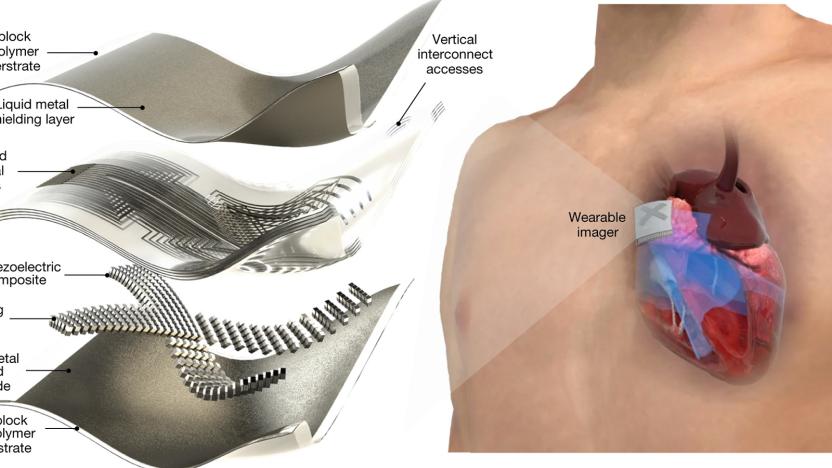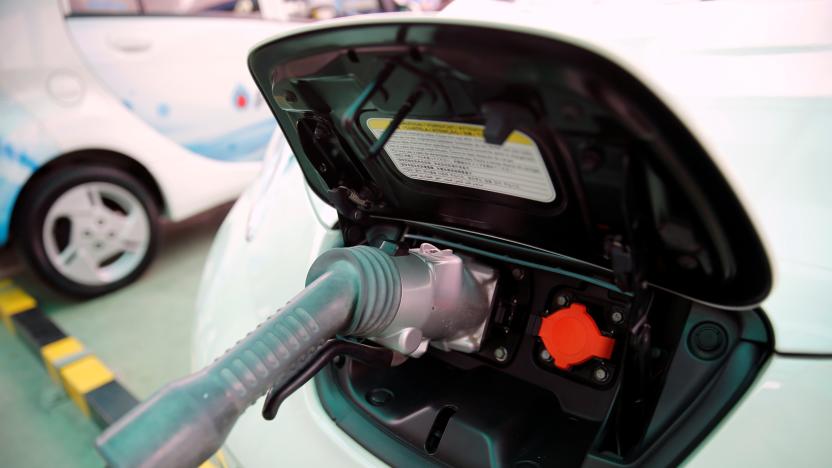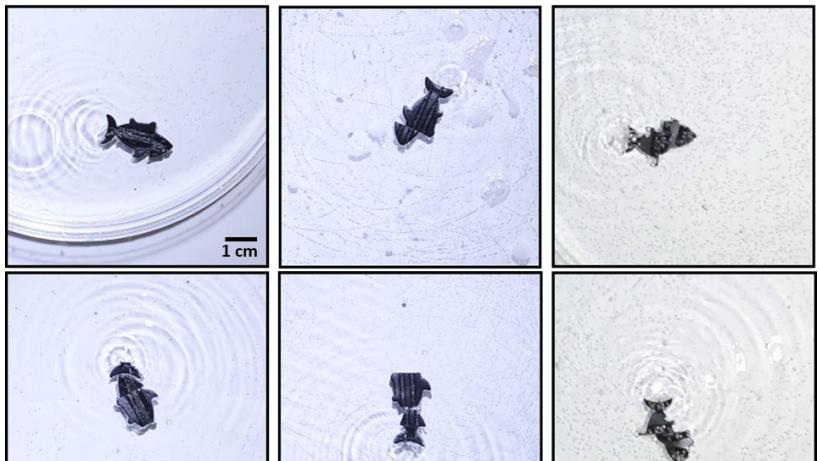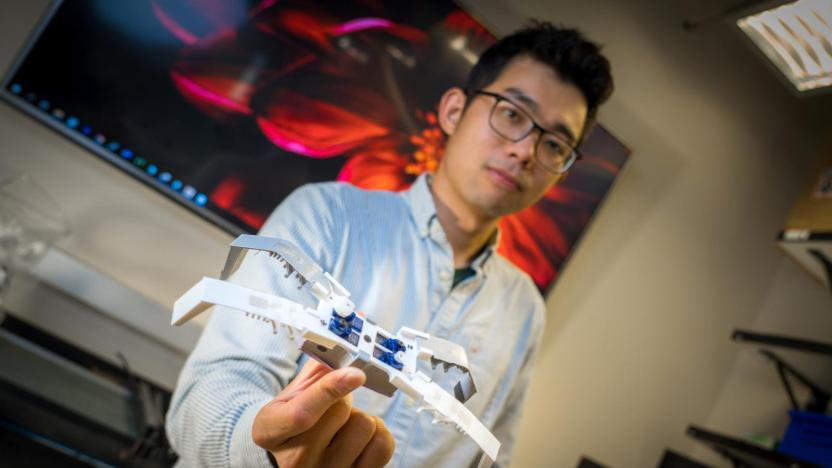UC San Diego
Latest

Wearable ultrasound patch could offer real-time heart scans on the go
A wearable ultrasound patch could offer real-time pictures of your heart — even while you're working out.

Solid-state silicon batteries could last longer and charge faster
Researchers have created a solid-state battery with an all-silicon anode that could potentially deliver long life, high energy density and fast charging.

Researchers create a swimming robot that can 'heal' itself
Researchers at UC San Diego created a tiny robot shaped like a fish that could reassemble itself when broken apart.

Solar System 'superhighway' could speed up space travel
Scientists have discovered a Solar System 'superhighway' that could lead to faster, more efficient space travel.

Scientists can 3D print insect-like robots in minutes
3D-printed 'flexoskeletons' make it possible to build a soft robot in less than two hours without extravagant costs.

Google releases Course Builder, takes online learning down an open-source road
Google is well-known for projects with unexpected origins. It's almost natural, then, that the code Google used to build a web course has led to a full-fledged tool for online education. The open-source Course Builder project lets anyone make their own learning resources, complete with scheduled activities and lessons, if they've got some skill with HTML and JavaScript. There's also an avenue for live teaching or office hours: the obligatory Google+ tie-in lets educators announce Hangouts on Air sessions. Code is available immediately, although you won't need to be grading virtual papers to see the benefit. A handful of schools that include Stanford, UC San Diego and Indiana University are at least exploring the use of Course Builder in their own initiatives, which could lead to more elegant internet learning -- if also fewer excuses for slacking.

Physicist uses math to get out of a traffic ticket, publishes findings
When most folks get ticketed for running a stop sign, most people wind up writing the court a check. UC San Diego physicist Dmitri Krioukov wrote a mathematical paper instead. Rather than throw his fallible human opinion on the mercy of the court, Krioukov uses a series of equations and graphs to prove that the accusing officer confused his car's real space-time trajectory "for a trajectory of a hypothetical object moving at approximately constant linear speed without stopping at the stop sign." In other words, the officer was wrong, but Krioukov stresses that it isn't the officer's fault. "This mistake is fully justified," he writes, pointing to the math. "As a result of this unfortunate coincidence, the O's perception of reality did not properly reflect reality." And to think, you probably never thought you'd use this kind of math in the real world.

Our annual data consumption estimated at 9.57 zettabytes or 9,570,000,000,000,000,000,000 bytes
The internet is a mighty big place that's only growing larger each day. That makes it a perfectly unwieldy thing to measure, but the traffic it generates has nonetheless been subjected to a rigorous estimation project by a group of UC San Diego academics. Their findings, published online this month, reveal that in 2008 some 9.57 zettabytes made their way in and out of servers across the globe. Some data bits, such as an email passing through multiple servers, might be counted more than once in their accounting, but the overall result is still considered an under-estimation because it doesn't address privately built servers, such as those Google, Microsoft and others run in their backyards. On a per-worker basis (using a 3.18 billion human workforce number), all this data consumption amounts to 12GB daily or around 3TB per year. So it seems that while we might not have yet reached the bliss of the paperless office, we're guzzling down data as if we were. Check out the report below for fuller details on the study and its methodology.

Audi commissions four US universities to research urban mobility issues
We've seen what other companies have in store for our automotive future, and now Audi's given us a glimpse of what we can expect from its car of tomorrow. The company's Silicon Valley research lab has teamed up with four universities here in the US to develop technologies that will give city drivers the full KITT treatment -- vehicles that recognize the driver (and his or her preferences) and can detect and avoid dangers and traffic delays. Called the Audi Urban Intelligence Assist initiative, each participating university has a specific area of urban mobility research ranging from urban crash analysis to aggregating historical and real-time traffic, parking, and pedestrian data in cities. The schools will also study how best to deliver relevant information to drivers and get them from point A to point B as easily and efficiently as possible. Looks like the groundwork is being laid for a German counterpart to GM's EN-V we test drove in Vegas, and we look forward to the fruits of their labor. Ich bin ein Ingolstädter!

Researchers use sensors to find the perfect surfboard, Gidget still looking for that perfect bikini (video)
Surfing and science are something of an odd mix, but we've seen time and time again that the two subjects to together like, well, salt and water. The latest high-tech stick to hit that briney mix comes from a team at UC San Diego, who outfitted a board with eight sensors on the bottom that measure the speed of the water as it rushes beneath. All are controlled by a waterpoofed computer embedded in the nose, which transmits data wirelessly to an Eee PC left sadly on the beach while its partner splashes around in the waves. The goal is to attempt to determine what level of flex is optimal and, once determined, to create the ultimate board and rule the world... the surfing world, at least.

Graduate student erases pedestrians from Google Street View
We love Google, oh yes we do, but there's no question the company could use some brownie points when it comes to privacy. That's not to say Mountain View doesn't try -- the firm does blur license plates and faces in Street View when it's not unintentionally snooping our WiFi. However, a UCSD graduate student has a more thorough idea: simply make the pedestrians disappear entirely. Arturo Flores' algorithm does just that, determining what to erase and what to keep using two adjacent frames. Because Google's roaming cameras end up taking images of the same subject from multiple angles, the program can grab bits of the background (in this case, the sidewalk, lawn and building) from either side, then layer them over the pedestrian in the foreground to hide him from view. It doesn't yet work on persons who are walking the same direction as the camera, or when there are many in the frame, but these obstacles can be surmounted at a later date. Here's hoping Google's PR team gives Arturo a buzz, so we can finally enjoy architecture without all those pesky humans in the way.

UC San Diego researchers repurpose 3D HDTV for heads-up VR system
Off the shelf 3D HDTVs may still be a bit expensive from a consumer's point of view, but they're a downright bargain compared to the usual high-end virtual reality gear. This gave some researchers at UC San Diego a bright idea: they've paired a $2,300 Samsung 3D TV with a half-silvered mirror and a touch-feedback controller for a haptic-enabled heads-up virtual reality system (or HUVR) that costs just $7,000 (without head tracking). What's more, they say their system actually outperforms the PARIS HUVR system developed twelve years ago (and still in use), which cost a full $100,000. Head on past the break for a quick video of the rig in action. [Thanks, Chase]

Scientists create sweat-monitoring underwear, break them in (video)
Biochip bracelets be damned -- nanoengineers at UC San Diego want to put sensors in your skivvies. Researchers have begun prototyping a pair of tighty-whiteys coated with the requisite carbon electrodes to make electrochemical computing a reality, as it turns out the nether regions are a prime place to measure chemicals excreted in one's sweat. Until recently, there was some question whether the enzyme sensor solution would handle the stresses of daily life, so to speak, but these briefs were up to the task -- subjected to a torturous gauntlet of bending and stretching, a treated elastic waistband was still able to adequately measure chemicals as required. Funded by the U.S. Office of Naval Research, project leaders envision "smart underwear" that measures a soldier's sweat for warning signs and automatically trigger an appropriate medical dosage. We think they might be getting a wee bit ahead of themselves, though -- we don't yet know how they handle detergent, let alone a quality color-safe bleach. Video after the break, but don't expect any footage of the underpants actually being worn.

Nine HDTVs form 3D visualization rig, but only in the name of science
If you're the kind of person who happens to have a number of LCD HDTV's lying around, we suggest you give University of California, San Diego's Calit2 Visualization Team a ring. Researchers from the group have constructed a three-column, nine-panel 3D display using flat screens from JVC, stereoscopic glasses, and "game PCs with high end NVIDIA game engines." Dubbed NexCAVE, it's a much more inexpensive version of the its projector-powered StarCAVE used for data analysis, although its range is more limited -- on the plus side, however, since this is LCD, it can be used in bright rooms. At 6,000 x 1,500 pixel, the resolution isn't as mind-blowing as we'd hope, but the team is currently building a version for Saudi Arabia's King Abdullah University for Science and Technology (KAUST) that's 7 columns (totaling 21 panels) and 15,000 x 1,500 resolution. If nothing else, any chance we can play Mirror's Edge on this? Video demonstration of the nine-panel rig after the break. [Via PhysOrg]

Somniloquy external networking card lets PCS "sleep talk" essential connectivity functions
Some researchers at UC San Diego, teamed up with Microsoft Research, have a novel new method in the works to let your computer save on power in sleep mode while still keeping up with IMs and whatever other network activity you pesky folks might be up to. Dubbed "Somniloquy," the USB dongle acts as an external networking card, and takes over most of the communication duties, with its own embedded OS and flash memory (similar to the Killer NIC). When the computer goes to sleep, Somniloquy maintains IM connections, ongoing downloads and torrents, and keeps your computer present on the local network and wireless LAN. If an activity arrives that needs the full computer, Somniloquy wakes up the computer and patches it through -- going so far as to buffer downloads into flash memory, and then dump it periodically on to the hard drive. The wake-on network activity concept is nothing new, but Somniloquy really runs with it, and boasts up to 60 to 80 percent overall energy savings based on the person's usage habits. The device is currently in prototype stage, and in the future all its functionality could be integrated into a PC's network card -- and hopefully won't just be for the pros this time.

Scientists copy keys with computer imaging to make sure we feel insecure
Not satisfied with the time-honored traditions of lockpicking or bump keying, computer science professor Stefan Savage and a handful of grad students at the University of California at San Diego have developed a computer system that makes a functional copy of a key based solely on a photograph, regardless of angle or distance -- the image resolution just has to be high enough to make out the details. They claim they did this "to show people that their keys are not inherently secret" so they'll be more careful about flaunting them around in their Flickr photos, but we're worldly enough to know that they really did it to steal beer from rival frat houses. Shame![Via Switched]

Expression recognition turns humans into remote controls... for robots
Jacob Whitehill at UC San Diego's Jacobs School of Engineering has demonstrated a proof of concept that allows his facial expressions to speed-up and slow-down video playback. Pretty sweet. But we're more interested to hear that his project is part of a larger effort at the UCSD Machine Perception Lab (gulp) to use automated face recognition to "make robots more effective teachers." We can see the future now...Human: (frowning) Robot: Aw, my meat bag is sad, I will now give it a hamburger and turn on Golden Girls. Fortunately, human teachers who've somehow missed out on the billions of years of biologically evolution required to recognize the "oh face" can take advantage of this research as well. See a video demonstration of that after the break, face-controlled video here.

HIPerSpace monitor wall makes a great Grand Theft Auto IV canvas
Rolling around jacking up innocents and tossing Molotov cocktails is pretty enthralling on your vanilla 46-inch HDTV, but can you even imagine the rush of swiping a hot dog, burning out in someone else's whip and then snagging a new pair of kicks on this? Researchers (and gamers, obviously) down at UC San Diego have re-engineered their middleware to enable such masterpieces as this to be played on the big monolithic HIPerSpace screen, and needless to say, we can't imagine much real work getting done with this new functionality coming to light. Head on down to the gallery to see what you're missing -- science, research and 4.0 GPAs are such beautiful things. %Gallery-22388%

QRIO's turn as Kindergarten Cop
Remember how Sony sent one of their QRIO humanoid robots on a publicity stunt goodwill mission to a US preschool last year? Well it seems that their intentions were less than completely altruistic, because while the children -- ages two-and-under -- joyfully danced and played with the now-deceased bot, researchers from Sony and the University of California at San Diego's Machine Perception Laboratory were secretly videotaping and analyzing their every interaction. According to the study's recently-released results, QRIO's spy work revealed that, unsurprisingly, the toddlers developed an attachment to their artificial playmate, preferring to dance with the bot rather than alone, and eventually helping it up if it happened to topple over. Unfortunately this story is not all smiles and sunshine, however, as word of QRIO's double-life got back to the preschoolers, who reportedly overpowered their other robot companion, RUBI, and interrogated the hell out of it using a car battery and welding torch.[Via Robot Gossip]








